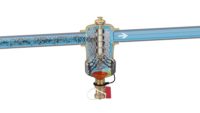Customers with steam heating systems often ask if there is any way for them to reduce operating costs. In addition, after asking, they note there is uneven heat distribution and want that resolved, too. Last, but certainly not least, they have received thermal burns from the hot radiators because 1 psi steam equals 215° F surface temperature. Older children and adults tend to make that mistake of touching, or grabbing the radiator just once!
From this mechanical contractor’s perspective, there are a number of options:
- Install TRV (thermostatic radiator valves), which are the only option if this is a one-pipe steam system (unless return lines are added and connected to every radiator) but work equally well for two-pipe systems. We installed dozens of TRVs in our town’s City Hall/Police Station two-pipe steam system, which lowered operating costs and resolved over/under heating in all areas;
- Lower the steam pressure! Most residential steam systems can operate very nicely on ounces instead of pounds steam pressure. Lower steam pressure reduces the amount of steam required to completely fill both piping and radiators. Less steam required to provide the same results equals lower operating costs;
- Replace old steam traps. Older steam traps often allow live steam to pass through, which is often the root cause for imbalances in heat distribution;
- Convert the boiler from 24/7 constant steam pressure to a heat on-demand only boiler. It simply makes no sense to have a steam boiler constantly maintaining live steam ready to go when a zone valve opens;
- Convert the steam system to a gently warmed water system, which can reduce operating costs by 30% to 70%. We have documented substantial operating cost reductions following conversion with a modcon boiler as the heat generation device; and
- Install inverter (variable speed) mini-splits with the added benefit of providing air conditioning. Here too, we typically saw a reduction in operating costs between 30% and 70%. In some cases, a combination of mini-splits and conversion from steam to gently warmed water with a modcon boiler were successfully completed.
Once a customer expresses interest in conversion from steam to gently warmed water, there are a logical series of things to consider:
- First and foremost, each radiator needs to be surveyed to ensure it can be utilized with water. If the radiator is not connected section-to-section across its top, then you have a steam-only radiator. For water to work, there must be flow across the top as well as the bottom of each radiator. Hot water radiators will also have a plug near the top of the end section where you can drill and tap for a threaded loose key air vent to ensure the radiator can be filled with water. A threaded plug is utilized to seal off the steam vent opening, if one was present;
- Look for signs of any prior leaks and telltale signs will appear at the juncture between sections, along the bottom of sections or obvious water damage to flooring can be seen below the radiator;
- The condition of all exposed piping throughout the distribution steam piping;
- Decide if a hot water union return elbow is to be included or removal of steam trap guts to allow for water to freely flow into return piping; and
- Assuming all the above conditions are met, bank on removing the steam radiator valve and replace it with a hot water radiator valve. Steam valves, if in good condition, can totally stop water flow while a hot water radiator valve has a small hole drilled in its seat disc to allow a small trickle of water to flow through even if the valve is turned off. Imagine a room where the owners turn off the valve and close the door. In cold weather, that radiator, if no flow is present, can freeze and break.
The most important and final determination if converting from steam to gently warmed water is performing a Manual-J heat loss calculation so that you know the Btu/h heat loss for each room. Hot water systems are sized to the actual heat loss whereas steam systems are sized to the connected load. [NMK1] The connected load is calculated by measuring each radiator’s height, number of sections and type of radiator (column or tube). Converting each radiator to EDR (equivalent direct radiation) will provide you with the Btu/h output at various water temperatures. My default go-to is the Burnham Heating Helper booklet. Turn to pages 42 through 47 and you will find the Btu/h output per square foot EDR at various water temperatures listed.
Here is where you can now define your system water temperature required on the design day (coldest outdoor ambient air temperature each year) to meet, or beat the actual Btu/h heat loss for the room. The good news is that almost all steam systems have oversized radiators. Some of that was due to the 1918 flu pandemic because it was believed, at that time, that stale indoor air was a contributing factor contributing to illness, so radiators were deliberately oversized to allow windows to be left partially open all winter. Other factors contributing to steam radiators being oversized include insulation added in the past, new windows and/or new doors. The weakest link will be the lone radiator that requires the hottest water temperature on the design day. That will determine the upper water temperature for the modcon’s outdoor reset curve, and the beauty of having cast iron radiators is they make wonderful radiant radiators (less convective and more radiant) at lower water temperatures. I found that most steam conversions to gently warmed water only needed a maximum of 140° F water on the design day. Modcons today incorporate a “boost” feature that will automatically begin raising the targeted water delivery temperature if the thermostat is still not satisfied after the period of time you program. This ensures that even if outdoor winds, for example, suck more Btu from the home, the water temperature will rise by set increments until the thermostat is satisfied.
During one convention I attended, my good friend Richard Trethewey, of “This Old House” made the statement that for every three degrees we can lower hydronic heating water temperature, there will be a 1% reduction in operating costs. While I knew our conversions were saving our customers lots of money, that was the first time anyone laid down the calculation for energy conservation. Upon returning home, I reviewed the conversion jobs where our customers had accurately tracked their reductions in energy usage. I then compared each one year-to-year, before and after, using heating tracked before/after energy costs. I utilized heating degree days to be more accurate while comparing year-to-year energy consumption and found that, while not an exact calculation, Richard’s 3:1 ratio was pretty much spot-on.
All the churches we converted averaged from 38% to 75% reduction in energy consumption. We converted my brother’s home after his steam boiler cracked and installed a modcon, indirect water heater and a home run system from each radiator with thermostatic radiator valves in the second-floor bedrooms since they were now empty nesters and wanted to lower the room temperatures unless the kids (now adults) come home to visit. His gas bills dropped off so dramatically that the local gas company wanted to stop by, no doubt thinking he was stealing gas!
Our office building incorporated upper-floor apartments and our elderly tenants had control of the thermostat. They set the thermostat to 85° F, which was way too warm for us when we relocated our offices to the first floor from an all-to-cramped office outbuilding. I installed a thermostat, set to 78° F, on the first floor and left the old thermostat on the second floor as a dummy thermostat — hoping they might not realize it was not controlling the heat, which resulted in the elderly ladies threatening to hang me from the nearest tree unless we turned the heat back up! We rapidly changed from steam to a three-zone hot water system utilizing a modcon boiler.
For every modcon conversion from steam, we utilized primary/secondary piping. The primary loop circulates the required gpm flow rate with an ECM (electrically commutated motor) set to a fixed speed and the secondary loop, which is hydraulically uncoupled by using closely spaced tees, also has a Delta-pressure ECM circulator set to modulate gpm flow rate as needed for its best energy conservation. Additional zones utilize 1-watt zone valves. As zone valves open/close, the ECM circulator modulates the gpm flow rate. This then completes the electrical side of energy conservation that is often overlooked. We do the same for existing hot water systems where an older single-speed boiler is replaced with a modcon. Unlike steam conversions where we can utilize the full range of the outdoor reset curve (75° F to design day water temperature required), the type of heat emitter determines how low we can go with water delivery temperatures. Copper tube finned baseboard, for example, has a floor of 110° F for the outdoor reset curve.
Aside from concerns that the existing steam piping or radiators would potentially leak once converted to water, there exists one looming issue: Iron suspended in the hydronic water that can and will foul modcon heat exchangers if not addressed. A strainer followed by a magnetic filter is required and chemical treatment is needed to halt further formation of iron oxides. Strainers can easily be flushed and the magnetic filters need to be cleaned during the annual boiler/system service. Hydronic water pH also needs to be checked and adjusted to be alkaline if required.




